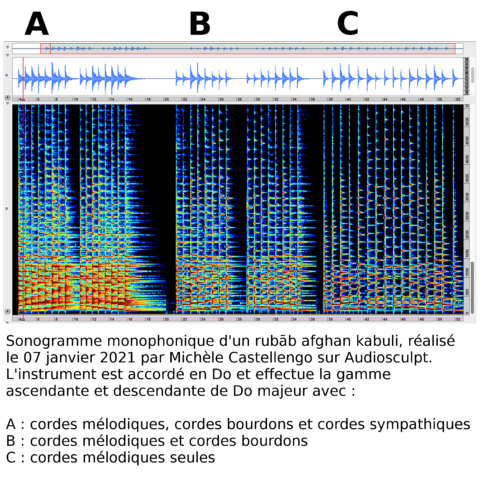
Image: representation of three sonograms A, B and C. Monophonic sonogram of an Afghan rubāb kabuli, made on 07 January 2021 by Michèle Castellengo on Audiosculpt. The instrument is tuned in C and performs the ascending and descending scale of C major with: A: melodic strings, drone strings and sympathetic strings B: melody strings and drone strings C: melody strings only
Although it is not easy to define the timbre of the Afghan rubāb, it is nonetheless recognisable. If we accept the idea that the instrument was invented at the beginning of the 19th century. The tone that is the benchmark today only appeared in the second half of the 20thcentury. It is partly due to the musician Mohammad Omar (1905-1980). The luthier Juma Khan Qâderi from Kabul became known as one of the finest craftsmen of his time. The timbre of his instruments, in the hands of Mohammad Omar, is a benchmark.
The tone of the Afghan rubāb is based on five elements:
- a carved and hollowed out mulberry wood structure;
- a complex cavity made up of three chambers;
- a taut, parchment-like goatskin;
- 3 melodic nylon strings;
- 13 to 15 sympathetic metal strings.
The sympathetic strings play a major role in creating the tone of the instrument. They double the notes emitted by the melodic strings, but other sympathetic strings often vibrate as well (sonogram image A). The sympathetic strings generate a halo of sound, a kind of mechanical reverberation similar to that of a large empty room. Charles Besnainou and Michèle Castellengo refer to this effect as the ‘cathedral effect’. (Besnainou, Castellengo 1995 : p. 61). One might think that the presence of sympathetic strings would increase the loudness of the instrument, but in fact there is no significant difference (sonogram image C). The level of loudness is identical in all three sonograms (sonograms A, B and C). The extension of the sound, known as the ‘rebound effect’, is of a much lower intensity than that produced by the exciter string.
The tone is also modified by the backward inclination of the bridge and by the shape and material of the plectrum. Empty, open eggshells are sometimes found inside the resonator, in the lower chamber. The significance of this practice is still unknown, but according to acoustician Michèle Castellengo, these eggshells have no effect on the instrument's acoustics. Last but not least, the instrumental gesture of the musician: his plectrum playing combined with the action of his fingers on the neck completes the timbre of the Afghan rubāb.